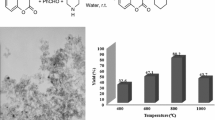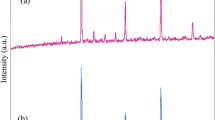Abstract
A study concerned to thermogravimetric analysis is performed in cesium dihydrogen phosphate (CsH2PO4) that was synthesized, using cetyltrimethylammonium-bromide (CTAB), polyoxyethylene-polyoxypropylene (F-68) and mixture of (F-68:CTAB) with two mole ratio 0.06 and 0.12 as surfactant. The dehydration behavior of particles was studied using thermal gravimetric analysis and differential scanning calorimetric. Subsequently, the experimental results indicated that the first dehydration temperature in the range of 237–239 °C upon heating, the second peaks occur at temperature range 290–295 °C and overlapping in the thermogravimetric events is observed. The mass loss values are obtained in the range of 6.62–6.97 wt% that is less than reported theoretical value 7.8 wt%. These values show well compatibility of reaction CsH2PO4 to Cs2H2P2O7 with 3.92 wt% whereas mass loss value of CsH2PO4 to CsPO3 is less than theoretical value 7.8 wt%. The activation energy of two steps dehydration are calculated using Kissinger equation for the samples synthesized via CTAB and (F-68) with minimum value mass loss 6.62% and maximum value mass loss 6.97%, respectively. The calculation results reveal that the reaction rate in the first step (CsH2PO4 → Cs2H2P2O7) is faster than the second step (CsH2PO4 → CsPO3). The weight loss values of the samples demonstrate that existence of CTAB can be considered as effective factor which prevents more weight loss during the dehydration process.




Similar content being viewed by others
References
Haile SM, Chisholm CRI, Boysen DA, Sasaki K, Uda T. Solid acid proton conductors: from laboratorycuriosities to fuel cell electrolytes. Farad Disc. 2007;134:17–39.
Baranov AI, Grebenev W, Khodan AN, Dolbinina VV, Efremova EP. Optimization of superprotonic acid salts for fuel cell applications. Solid State Ionics. 2005;176:2871–4.
Otomo J, Minagawa N, Wen C, Eguchi K, Takahashi H. Protonic conduction of CsH2PO4 and its composite with silica in dry and humid atmospheres. Solid State Ionics. 2003;156:357–69.
Haile SM. Materials for fuel cells. Mate Today. 2003;18:24–9.
Baranova AI, Kopnin EM, Grebenev VV, Sin A, Zaopo A, Dubitsky Y, et al. Influence of humidity and thermal decomposition on the protonic conductivity of single and polycrystalline CsH2PO4. Solid State Ionics. 2007;178:657–60.
Boysen DA, Hiale SM, Liu H, Secco RA. High-temperature behavior of CsH2PO4 under both ambient and high pressure conditions. Chem Mater. 2003;15:727–36.
Bronowska W. Does the structural superionic phase transition at 231 1C in CsH2PO4 really not exist? J Chem Phys. 2001;114:611–2.
Metcalfe B, Clark JB. Differential scanning calorimetry of RbH2PO4 and CsH2PO4. Thermochim Acta. 1978;24:149–53.
Kucheyev SO, Bostedt C, Van Buuren T, Willey TM, Land TA, Terminello LJ, et al. Electronic structure of KD2xH2 (1-x) PO4 studied by soft x-ray absorption and emission spectroscopies. Phys Rev B. 2004;B70:245106–12.
Lee KS. Hidden nature of the high-temperature phase transitions in crystals of KH2PO4-type: is it a physical change? J Phys Chem Solids. 1996;57:333–42.
Bronowska W, Pietraszko A. X-ray study of the high-temperature phase-transition of CsH2PO4 crystals. Solid State Commun. 1990;76:293–8.
Rajendran S, Mahendran O. Experimental investigations on plasticized PMMA/PVA polymer blend electrolytes. Inetr J Ionic. 2001;7:463–9.
Wada M, Sawada A, Ishibashi Y. Some high-temperature properties and the Raman-scattering spectra of CsH2PO4. J Phys Soc Japan. 1979;47:1571–4.
Gupta LC, Rao URK, Venkateswarlu KS, Wani BR. Thermal stability of CsH2PO4. Thermochimica Acta. 1980;42:85-90.
Baranov AI, Khiznichenko VP, Sandler VA, Shuvalov LA. Frequency dielectric dispersion in the ferroelectric and superionic phases of CsH2PO4. Ferroelectrics. 1988;81:1147–50.
Park JH. Possible origin of the proton conduction mechanism of CsH2PO4 crystals at high temperatures. Phys Rev. 2004;B69:054104–6.
Uda T, Taninaouchi YK, Awakura Y, Ikeda A, Haile SM. Dehydration behavior of the suerorotonic conductor CsH2PO4 at moderate temperature: 230 to 260 oC. Electrochem J Mater Chem. 2007;17:3182–9.
Burnham AK, Weese RK, Wemhoff AP, Maienschein JL. A historical and current perspective on predicting thermal behavior. J Therm Anal Calorim. 2007;89:407–11.
JCPDS-ICDD 1995;35:746.
Sánchez-Jiménez PE, Criado JM, Pérez-Maqueda LA. Kissinger kinetic analysis of data obtained under different heating schedules. J Therm Anal Calorim. 2008;94:427–32.
Acknowledgements
The authors appreciate the financial support of the IRPA-02-02-02-0006 PR0023/11-08. This work was conducted at the Institute of Fuel Cell University Kebangsaan Malaysia, Selangor, Malaysia.
Author information
Authors and Affiliations
Corresponding author
Rights and permissions
About this article
Cite this article
Hosseini, S., Mohamad, A.B., Kadhum, A.H. et al. Thermal analysis of CsH2PO4 nanoparticles using surfactants CTAB and F-68. J Therm Anal Calorim 99, 197–202 (2010). https://doi.org/10.1007/s10973-009-0132-2
Received:
Accepted:
Published:
Issue Date:
DOI: https://doi.org/10.1007/s10973-009-0132-2




